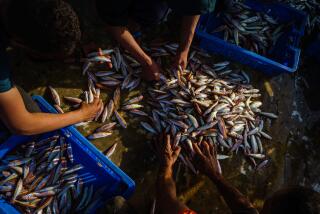Cheetahs and pumas may have hunting strategies down to a science
- Share via
It’s not easy being a lean, mean killing machine. Whether a fleet-footed cheetah or a lie-in-wait puma, a hunting feline’s survival balances on the point between how much energy they lose in hunting for a meal and the energy they gain from actually eating it. Now, two new studies in the journal Science follow these big cats to find out how they make this lifestyle work.
Being a top predator might seem like an enviable position. After all, generally speaking, no one’s trying to eat you. But it comes with some serious drawbacks when nabbing a meal. Think about it: If you’re a typical herbivore – a zebra or a deer – you find a plant, you stand there and eat the plant. Aside from dealing with a large-scale environmental crisis, like drought, getting grub is pretty straightforward.
For carnivores, what you want to eat is sometimes bigger than you, it can sometimes fight back and it might even be able to outrun you. A carnivore runs the risk of spending a lot of energy for just one meal and ending up empty-clawed.
It’s pretty difficult to tell how these hunters minimize these energetic costs in nature, on often rugged and unforgiving terrain. So in a study led by Terrie Williams of UC Santa Cruz, researchers devised a clever way to track this energy consumption. They created SMART collars (short for “species movement, acceleration and radio tracking”) that helped them link the animals’ energy consumption to a variety of different behaviors, including resting, eating and running.
They captured four wild pumas, outfitted them with the devices and released them into a roughly 650-square-mile study area in the Santa Cruz Mountains.
The scientists found that the pumas used a variety of different styles, “ranging from low-cost sit-and-wait behaviors to constant movements with energetic costs averaging 2.3 times those predicted for running mammals,” they wrote.
But to mitigate those energy costs, they tended to keep still and stay out of sight. And when they did attack, they were able to precisely match their pouncing force to the size of their unlucky prey – leaving very little energy wasted.
It makes sense, the authors wrote. Killing an animal may seem like a lot of work, but actually doing the deed takes up a small slice of their day. Searching for that prey, however, takes a lot of time and energy.
A second study looked at a hunter with a very different style – the cheetah, which engages in high-speed chases to bring down, say, a gazelle. While the cheetah is fast, it’s vulnerable to other predators (like lions and hyenas) who muscle in after the cheetah’s done all the work and steal the meal.
So on top of having to work hard to get a meal, the cheetah can easily lose it to another predator. How does it deal with these costs? An international team took 19 cheetahs and administered doses of doubly labeled water (water whose hydrogen and oxygen atoms have been replaced with heavier isotopes). They used the isotope-tagged water to track the cheetahs’ energy expenditure over time, collecting urine samples as the animals roamed around parks in southern Africa.
The scientists found that the cheetahs can offset their losses from stolen food (a phenomenon called kleptoparasitism) by traveling wider distances. They could actually deal with a 25% kleptoparasitism rate, because it would require only an additional 1.1 hours of time and 12% extra daily energy expenditure to make up for the loss. As long as there’s enough prey to go around, the thievery didn’t affect their energetic bottom line too much.
“It shows that cheetahs are well adapted to the presence of competitors and that costs incurred by traveling drive their energy budgets, rather than those encountered securing prey,” the study authors wrote.
Ultimately, the biggest concern for cheetahs sounds very similar to that of the puma study: Doing the long-term legwork while looking for food is much more costly than actually sealing the deal.
“Intuitively, one would think that the extreme physical exertion of chasing and pouncing on prey would far outweigh the searching process,” John Laundré of UC Riverside, who was not involved in either study, wrote in a commentary on the papers. “As both studies point out, however, although subduing prey is energy-intensive, the time spent doing this is short. Carnivores either quickly capture their prey or give up.”
Both teams indicate that humans’ effect on these animals’ natural habitats could profoundly alter that delicate energy equation. In the case of pumas, loss of vegetation – natural cover – makes it harder to sneak up on prey. In the case of cheetahs, lower numbers of animals on the African plains means that the big cats have to travel farther to search for food.
“In either case, these changes can increase the energy that predators expend in both seeking and subduing prey, and thus threaten their survival,” Laundré wrote. “In this case, conservation of adequate habitat and prey abundance become paramount in efforts to conserve large carnivores.”
That’s worrisome, given that apex predators play an important role in keeping their ecosystem in balance -- and they’re in decline.
Think cheetahs never prosper? Follow @aminawrite for more science news from the animal kingdom.







